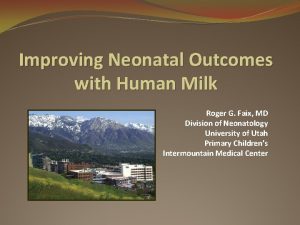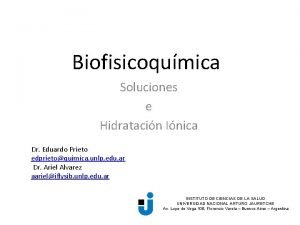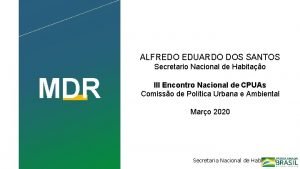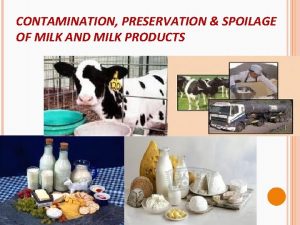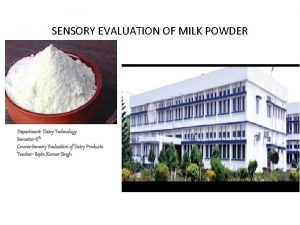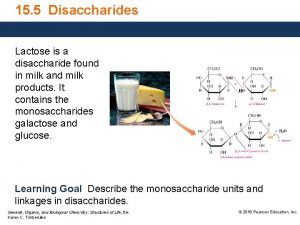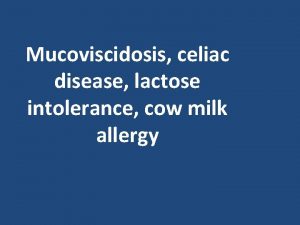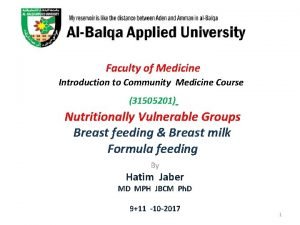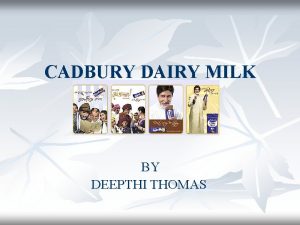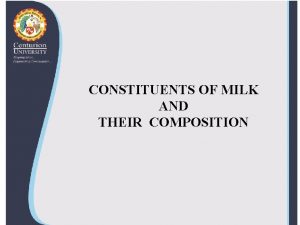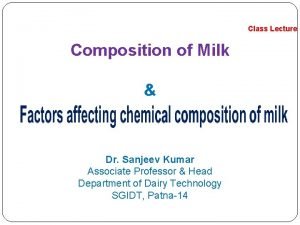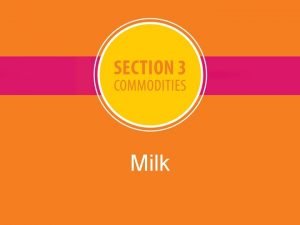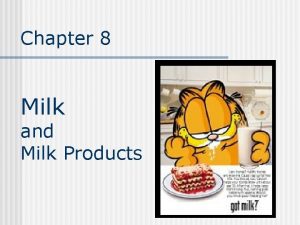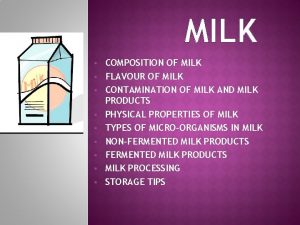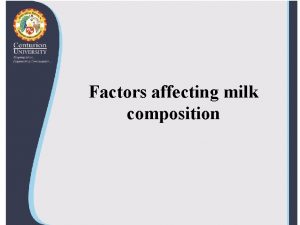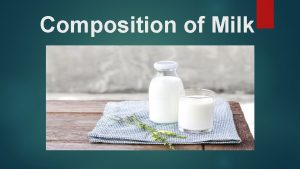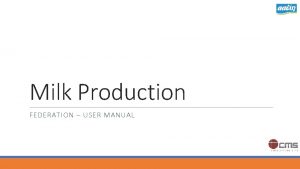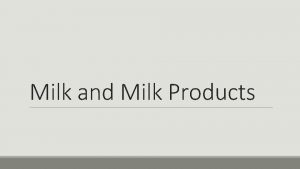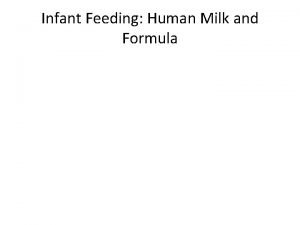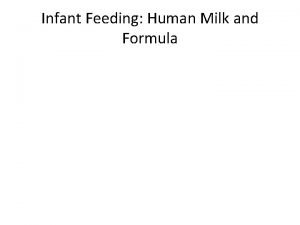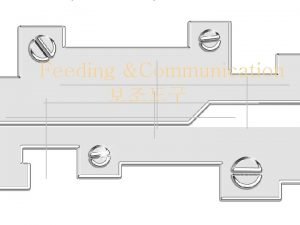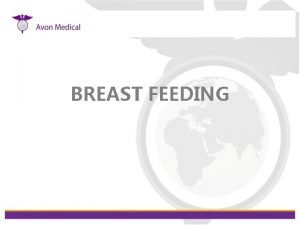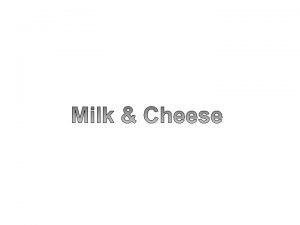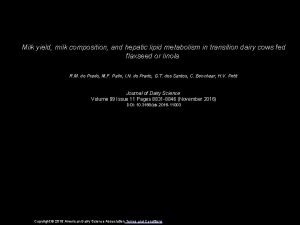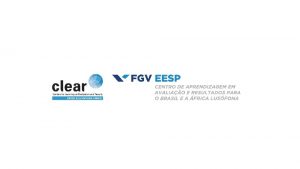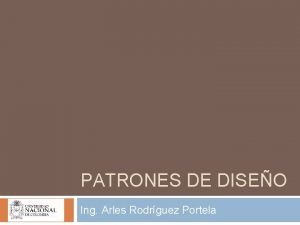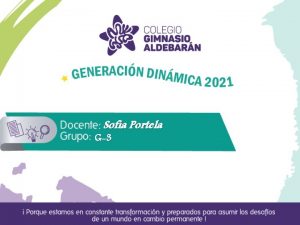FEEDING FOR MILK COMPOSITION Jos Eduardo Portela Santos































- Slides: 31

FEEDING FOR MILK COMPOSITION José Eduardo Portela Santos VMTRC – UC Davis

Milk Components • Fat – Content – Fatty acid profile • Crude protein – Content – True protein vs NPN • Lactose • Minerals and vitamins

• Several nutritional factors affect the composition of milk of dairy cows: – Energy intake (Mcal of NEL) – Energy source • CHO • Lipids – Protein intake – Protein degradability and quality – Interactions between protein and energy – Amino acids – Minerals: Na, K (DCAD) – Feed additives (Niacin, fibrolytic enzymes)

Milk Fat • Forage: Concentrate ratio • CHO: – NDF – Effective NDF – Physically effective NDF – Ruminal digestibility of NDF – NFC • Composition of the NFC: sugars, starch and pectin • Ruminal degradability of starch

• Ionophores • Fat supplementation • Lack of RDP (fiber digestibility and buffering effect) • Dietary buffers

Theories • Low fat diets • Acetate deficiency • B-OH-butyrate deficiency • High rumen molar concentration of propionate: Insulin theory (glucogenic theory) • Vit. B 12 deficiency • Trans fatty acids





Mechanism of Action of Trans FA • Milk fat suppression: reduced SCFA (De Novo synthesis) • Trans fatty acids depress milk fat in 48 to 72 hs • Preliminary data from Maryland (Piperova et al. , 1998): – Acetil Co. A Carboxylase activity decreased (61%) – Fatty acid synthase activity decreased (54%) – Acetil Co. A Carboxylase m. RNA decreased (55%)

Nutritional Causes of Milk Fat Suppression • Inadequate NDF • Inadequate physically effective NDF (particle size) • Poor NDF digestibility • Forage source: buffering capacity • Excessive amounts of NFC • Excessive amounts of RDS • High fat diets

• Fat sources with highly unsaturated FA profile – Yellow grease, oils • Interactions between fat source and forage source (binding sites) – Alfalfa hay vs corn silage • Protein supplements with high PUFA content – Fish meal, blends of marine by products • Lack of RDP (fiber digestibility & buffer effect) • Lack of buffers

Milk Protein • NEL intake • Forage: Concentrate ratio • Amount of fermentable CHO (RDS) • Dietary CP level • Amino acid profile of the protein flowing to the duodenum • Dietary fat




Effect of Grain Processing on Plasma Insulin P < 0. 05 • Data from 832 blood samples from 32 cows (Santos et al. , 2000)



• Diets with more fermentable energy increase milk protein: – Increase flow of microbial protein – increase molar concentration of propionate in the rumen – increase blood insulin

Dietary Protein and Milk Protein • Low efficiency of N utilization for milk protein synthesis (< 30%) • Sp rndly (1986): No relationship between dietary CP content and milk protein concentration • Emery (1978): correlation between dietary CP and milk protein content (r 2=0. 35) – The effect of higher CP diet is associated with greater DMI and total energy intake




Dietary Fat and Milk Protein • Negative relationship between dietary fat and milk protein concentration • Independent of fat source • Increased efficiency of amino acid extraction • Supplying more fermentable CHO or high quality RUP partially overcomes milk protein depression




Conclusions

 Cow milk vs human milk
Cow milk vs human milk Continuous feeding vs bolus feeding
Continuous feeding vs bolus feeding Eduardo prieto santos
Eduardo prieto santos Habitao
Habitao Contamination of milk and milk products
Contamination of milk and milk products Sensory evaluation of milk and milk products
Sensory evaluation of milk and milk products Lactose is a disaccharide found in milk
Lactose is a disaccharide found in milk Milk for toddlers with milk allergynon dairy
Milk for toddlers with milk allergynon dairy Human milk vs cow milk
Human milk vs cow milk Cadbury dairy milk
Cadbury dairy milk Composition of milk
Composition of milk Composition of milk
Composition of milk Treserva lathund
Treserva lathund Rita perspektiv
Rita perspektiv Redogör för vad psykologi är
Redogör för vad psykologi är Hur skriver man en debattartikel
Hur skriver man en debattartikel Tack för att ni lyssnade bild
Tack för att ni lyssnade bild Sju principer för tillitsbaserad styrning
Sju principer för tillitsbaserad styrning En lathund för arbete med kontinuitetshantering
En lathund för arbete med kontinuitetshantering Lek med geometriska former
Lek med geometriska former Dikt på rim
Dikt på rim Modell för handledningsprocess
Modell för handledningsprocess Fredsgudinna
Fredsgudinna Programskede byggprocessen
Programskede byggprocessen Orubbliga rättigheter
Orubbliga rättigheter Formel för lufttryck
Formel för lufttryck Presentera för publik crossboss
Presentera för publik crossboss Densitet vatten
Densitet vatten Jätte råtta
Jätte råtta Aktiv exspektans
Aktiv exspektans Romarriket tidslinje
Romarriket tidslinje Smärtskolan kunskap för livet
Smärtskolan kunskap för livet
